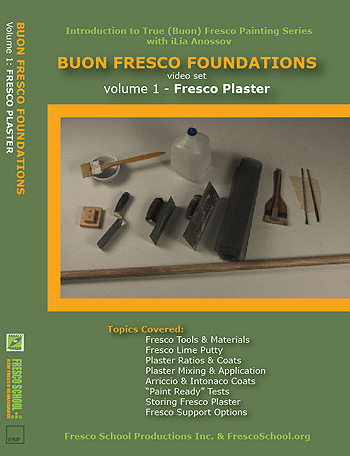
BFF Volume 1 – Fresco Plaster is the essential tutorial and a must-have for the study of the medium of fresco. After over 17 years of practicing the medium and teaching, I have concluded that the cause of 95% of the problems and failures is the incorrectly prepared and applied last painting plaster coat (Italian Name – intonaco).
Any fresco plaster which proportions are available from various random sources, is suitable for painting a fresco (as long as it is calcium lime based). However each variant has its own set of advantages and limitations which are related to style and application.
For example, Diego Rivera painted on “Roman Plaster”, using plaster mixture proportions similar to the ones used in Pompeii – where 1 part of calcium lime was mixed with 1 part of fine marble dust. This plaster is white and smooth and could be found easy to apply, however it is also very dense and has limited absorption rate. In other words, it takes color very slowly and gives best results when a similar to a watercolor technique or very stylized design is used. This method requires a formidable understanding of the medium and a good amount of practice painting using light delicate washes of transparent color or a particular style that employs very precise single layer, stencil like, application of mainly ornamental designs.
This plaster proportion was rarely used during the Renaissance when newly discovered aerial perspective, grid transfer and value range dependencies required plaster to absorb ample amounts of water from the paint as artist built the composition using multiple layers in gradient application. The plaster mixture for the final layer has been adjusted to accommodate for that thus Michelangelo and other masters for centuries used a mixture of 5 part lime putty to 8 parts of aggregate or even 1 part lime to 2 parts aggregate (aggregate refers to any or a mixture of – sand, marble sand, volcanic tuff, etc.)
After almost 2 decades of teaching fresco painting I have concluded that the most versatile and efficient fresco plaster proportions are the ones used during the Renaissance. Virtually any classic style of fresco (Aztec, Byzantine, Chinese, Egyptian, Inca, Italian, Roman, Etc) can be painted using a mixture of 5 part lime X 8 parts aggregate. More over, having experimented myself and with students for the past 15 years with both proportions, it is clear that 8X5 proportion is the key and a starting point in understanding the fresco plaster and painting.
BFF Volume 1 – Fresco Plaster is a detailed tutorial on the subject, This volume demonstrates in real-time principles and relationships between moisture, application and painting; size of the fresco, its style and the number and thickness of plaster layers relevant to the size and complexity. It addresses the painting time that is needed to complete a fresco and how to control the plaster to provide necessary “open time” using multiple plaster layers, known as scratch coat, brown coat, arriccio, intonaco. Among other parts, tutorial shows how to determine if the plaster is ready for painting – starting too early is the most common mistake!
I have created this tutorial by refining, organizing and expanding my day-to-day footnotes that I still refer to every time, especially to the thickness of the plaster vs. composition complexity chart. Although the Tutorial is focusing on the small portable fresco the directions and charts will prepare you for the wall sized fresco – fresco plaster itself, mixing methods and performance does not change with size.
Alternatively you can buy this DVD as part of the 5 Volume SET (at $65)
The set contains over 10 hours of narrated direct footage (running speed is 150% of the real-time) over 3 hours of visual information (diagrams, charts, lists etc.) as well as extensive lecture notes and tips. Topics illustrated include the entire step-by-step process filmed in real-time without omissions. A student will be able to see exactly how long each step takes and what tools and methods each requires. iLia Anossov (fresco) guides the student by a thorough and clear demonstration of the foundations of calcium fresco plastering, cartoon and pigments and paint preparation, verdaccio under-painting and multi-layer color application relevant to any size fresco.
